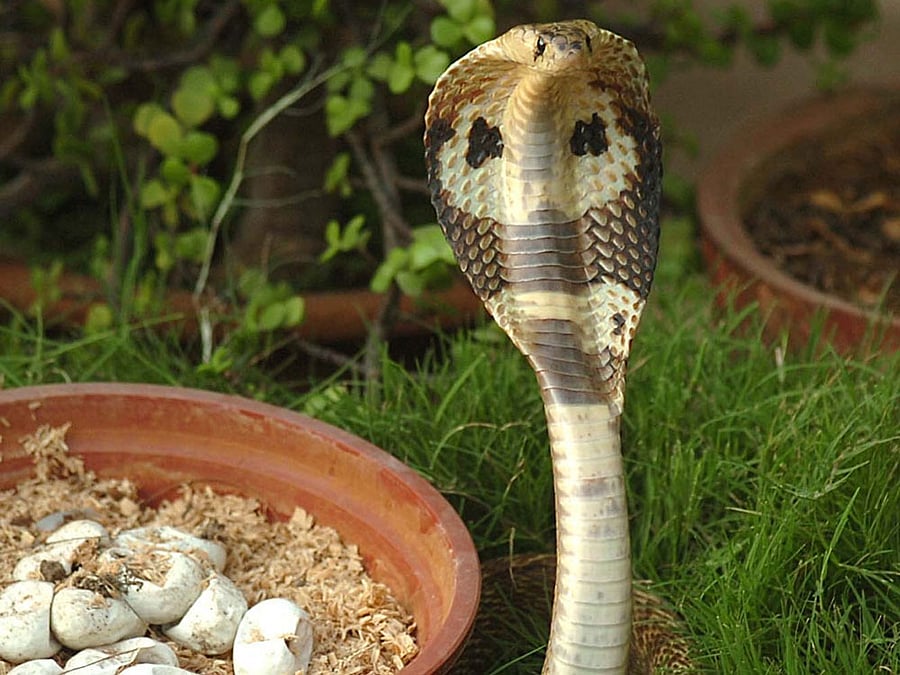Bitten by snake? Fret not, most serpent bites are just dry stings, says expertVenomous snakes often give dry bites to teach humans a lesson, says wildlife vet
Last Updated IST

Adult venomous snakes such as cobras have control over their glands. They bite people to create fear and buy their time to escape from the threat scene. DH FILE PHOTO
Be calm if you are bitten by a snake. It could just be a dry bite. Few people know that 70% of the times, venomous snakes give dry bites to teach humans (threats) a lesson and not to waste their venom, according to Roopa Satish, wildlife veterinarian, Wildlife Rescue and Rehabilitation Centre. She was speaking to an awestruck audience of children and adults at a World Snake Day event on Sunday. This was the first-ever such programme organised at the Bannerghatta Biological Park.
“Most of the time, it is the shock of the bite and the anti-venom rather than the venom itself which reacts and even kills people. Sadly, many people, including doctors, are not aware of this fact. When a person is bitten, s/he rushes to the hospital and doctors immediately administer anti-venom to him/her without ascertaining whether it is necessary. Doctors also do not understand the dosage that needs to be administered,” Dr Roopa said. “There have been instances of people dying because of the anti-venom rather than the venom. It is also the fear which takes a toll. The anti-venom leads to kidney and lung failures, even heart attacks.”
A dry bite is one where the snake bites without injecting its venom into the body of its prey (humans). There will be blood and pain, but no venom. This is mostly given by adult venomous snakes which have control over their glands. They do it to create fear and bide their time to escape from the threat scene. Around 60% to 70% of snake bites are dry bites and 95% snakes are non-venomous, she said.
If the victim remains calm and is diagnosed well, a Tetanus injection and a little bit of anti-venom will suffice. Some people get cured in just half-vial while others need even 50 vials. Once a person is bitten, s/he should check the type of the snake. While a cobra’s venom is neurotoxic, a viper’s is chemotoxic. Doctors should monitor blood pressure, heart rate and blood clotting. In the meantime, saline should be administered because if venom has been injected, then after 30 minutes, finding the vein will become very difficult. After 30-45 minutes, if pulse and clotting do not show improvement, then anti-venom should be administered, Dr Roopa explained.
Snakes are very intelligent and give a lot of signals for people to escape like hissing loudly and spreading out their hoods. The monsoon coincides with snakes’ breeding season. This is also the time when many young snakes sprout up. Young venomous snakes are more dangerous than adult ones. The juveniles have no control over their venom and lack experience. That’s why it is important for a person to remain calm, she added.
“Most of the time, it is the shock of the bite and the anti-venom rather than the venom itself which reacts and even kills people. Sadly, many people, including doctors, are not aware of this fact. When a person is bitten, s/he rushes to the hospital and doctors immediately administer anti-venom to him/her without ascertaining whether it is necessary. Doctors also do not understand the dosage that needs to be administered,” Dr Roopa said. “There have been instances of people dying because of the anti-venom rather than the venom. It is also the fear which takes a toll. The anti-venom leads to kidney and lung failures, even heart attacks.”
A dry bite is one where the snake bites without injecting its venom into the body of its prey (humans). There will be blood and pain, but no venom. This is mostly given by adult venomous snakes which have control over their glands. They do it to create fear and bide their time to escape from the threat scene. Around 60% to 70% of snake bites are dry bites and 95% snakes are non-venomous, she said.
If the victim remains calm and is diagnosed well, a Tetanus injection and a little bit of anti-venom will suffice. Some people get cured in just half-vial while others need even 50 vials. Once a person is bitten, s/he should check the type of the snake. While a cobra’s venom is neurotoxic, a viper’s is chemotoxic. Doctors should monitor blood pressure, heart rate and blood clotting. In the meantime, saline should be administered because if venom has been injected, then after 30 minutes, finding the vein will become very difficult. After 30-45 minutes, if pulse and clotting do not show improvement, then anti-venom should be administered, Dr Roopa explained.
Snakes are very intelligent and give a lot of signals for people to escape like hissing loudly and spreading out their hoods. The monsoon coincides with snakes’ breeding season. This is also the time when many young snakes sprout up. Young venomous snakes are more dangerous than adult ones. The juveniles have no control over their venom and lack experience. That’s why it is important for a person to remain calm, she added.
